After the first chemotherapy treatment my partner had for ovarian cancer, the rest of the sessions were oddly comforting, rather than scary. We knew what to expect. The nurses, particularly ours, were very good at what they do and very kind while they were doing it, from poking holes to explaining exactly what was happening and would happen. The drugs were actively fighting the cancer. We were fighting the cancer.
What follows is our routine: how time passed for us during a typical Chemo Day.
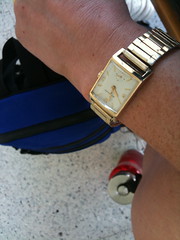

We left the house at quarter of nine, to give us time to fight through Boston traffic. We drove “the way we used to drive to Mulberry Tree daycare,” over the BU bridge, and past Russ’s [former] house. After a detour to the hospital’s Starbucks, we arrived at the reception area before the 10 o’clock appointment.

Both of us carried a number of totems with us, objects that family and friends gave us after the diagnosis. I was wearing the watch my Dad gave me that his parents had given him for his high school graduation and that he’d worn for most of my childhood. In my fancy new blue backpack, I had a little handmade bag closed with a windsurfer stick pin containing special rocks, sea glass, pine needles, a key from the house where I grew up, a capacitor and other objects. Even the red Oberlin College water bottle on the floor (you can see its aluminum top) is an object that makes me feel protected.
They measured Susan’s vitality (blood pressure, pulse, etc.) and took some blood. The greeter on Fridays came around with a cart, offering juice, tiny cans of ginger ale and coke, Lorna Doone cookies, saltines, and other treats. A ten-year volunteer who had breast cancer, she could read our faces and know whether or not one of us wanted to chat: not this time. We sat patiently waiting for the oncologist and her fellow (an MD practicing to become a specialist, in this case, in oncology).
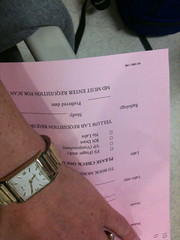
That particular day, we waited well over an hour to see the doctors. I didn’t mind. It’s a day of waiting: what was another hour? Susan, however, was edgy because by having an appointment two hours later than usual, we might keep the nurse past her shift. I reminded her that the nurses were scheduled to work until after we would be done. She worries a lot about her impact on other people: my reminder did not sooth her. At twenty after eleven, we had talked to the doctors and finally had the pink paper noting how much of which drugs were to be administered. The nurses get really cranky at the doctors if they have to chase after them because they’ve forgotten to fill out the pink paper.
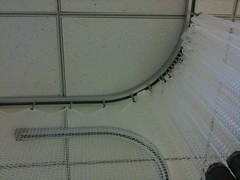
When our nurse was ready for us, we headed down the hall past the reception desk, hung a right after the two bathrooms, walked down a long hallway, and met her in Chemo B. They administer chemotherapy in two separate but connected sections, A and B. Each section has about as much floor space as a basketball court, but shaped in an L. There are nine or ten curtained areas along the walls, several chairs along the windows, and more chairs on the opposite side of the room. People who are there for just an hour sit in one of the open areas. Those who are there longer get a “room” with curtain walls, a TV on a long arm that reaches over the “comfy” chair, an IV pole or two, a cabinet with medical supplies, and a stool on wheels for the nurse. Every patient “gets” to sit in a blue recliner chair with a deep seat, cushioned arms, and headrest. The hard chair in the corner was for me. You can’t sleep in that chair. I’ve tried.

Once we took our respective seats, time sped up–the whirlwind of activity had begun. Our wonderful nurse, Linda, wrapped heat packs around Susan’s arm to bring her veins to the surface so that it would be easier to choose a good one for the intravenous catheter. I’ve learned a lot these past months. Did you know that the IV catheter is “just” a small tube they poke in the vein? I’d always thought it was a needle. A few minutes later, Linda pieced together the IV plumbing, connected it to the first of many bags of fluid that would flow into my partner’s bloodstream, opened one of the shut-off valves, and put in the catheter. I went to the kitchen to pour a mix of cranberry juice and water (no ice) so that she could take the giant anti-nausea pill. An aide came by, for the first of four times, to take her vital signs. She gratefully accepted the offer of warm blankets.
One of the volunteers came with the cart full of lunch bags. Although the small sandwiches were usually pretty good, my tuna salad had been plopped in the middle of the two pieces of now-soggy bread. I opened Susan’s chips for her, and ate my banana.
Enough of the saline had gone in; time to open the valve to the antihistamine bag. Unlike the others, that fluid burned as it went in. Could I get her one of those nut bars before they disappeared, and some hot tea (decaf, barely steeped, a pouch of Splenda, and a splash of milk)? I hopped up. When I came back, Linda was hooking up the steroid, to reinforce the antihistamine. Then came anti-nausea medication to reinforce the pill she’d taken earlier.
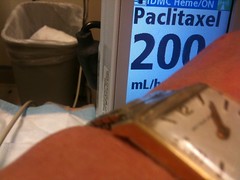
Finally, the initial hour and a half hubbub of bag after bag was over. It was time for the cancer-killers, the big guns. With protective clothing on, Linda brought in the two powerful drugs. Another nurse read the ID number from Susan’s wrist tag and had Susan confirm her date of birth aloud. Linda read aloud the drug and dose off each bag, which the other nurse repeated, reading aloud the doses from the orders. They are careful about everything, of course, but the hospital really doesn’t mess around with these drugs.

We each settled in for the three-hour-drip. I went to the well-stocked kitchen. There, one of the three volunteers spotted my Nebraska t-shirt and told me her daughter was in the western part of the state somewhere, in the middle of nowhere, studying black-footed ferrets, prairie dogs, and a disease they share. I poured decaf into my stainless steel coffee cup, picked up a little bag of chocolate chip cookies, and re-filled Susan’s cranberry juice/water mix. She took a sip, I helped her recline the chair, she opened her book, and was out like a light.
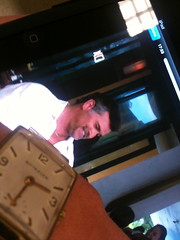
Now I had my cherished quiet time. Knowing that sometimes Susan woke up sooner than I’d expected, I decided to watch one of the TV shows stored on my iPad first. Dare I say that it was Burn Notice? There’s nothing like explosions, chase scenes, and a narrator’s tips about spying to make me relax. After one of the aide’s interruptions to take vital signs, Susan thought her nap was over, but went back to sleep when I told her I wasn’t done with my show.
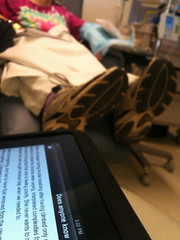
After Michael, Fiona, and Sam finished righting a wrong suffered by a “client,” I connected to the hospital’s wireless network, and checked my mail: nothing of consequence. I started writing a blog piece entitled “Does anyone know how it feels?” I can actually type pretty quickly on the iPad’s virtual keyboard. I drafted several pages, much of which I later edited out.
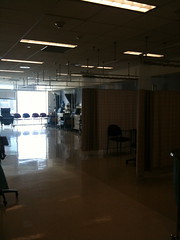
By the time Susan was ready to read her book with her eyes open, it was 4:30 pm. As she had feared: she was the last patient left. The room was empty. I reassured her, as I had in the morning, that the nurses’ shift wasn’t over. When Linda came in, Susan apologized for keeping her. Linda as told her, as she often does in her calming voice “don’t worry: it’s fine, really!”

She connected the last bag, the second cancer killer: Carboplatin. Yes, that’s right, it’s got platinum in it, the same metal that photographers used in the early twentieth century to create beautiful prints with an incredible tonal range. That’s what has made my partner so photogenic during chemo? Hmm.
We chatted with Linda about soccer and kids and, of course, our family’s number one team: the  Boston Breakers, part of the Women’s Professional Soccer league. The Carboplatin only takes a half hour, so I repacked our bags and got ready to leave so we could exit quickly. When the drip-controller started beeping, I went to the nurse’s back office to let Linda know. She carefully removed the IV and told us “see you next time.”
Boston Breakers, part of the Women’s Professional Soccer league. The Carboplatin only takes a half hour, so I repacked our bags and got ready to leave so we could exit quickly. When the drip-controller started beeping, I went to the nurse’s back office to let Linda know. She carefully removed the IV and told us “see you next time.”
We walked down the hall, used the restrooms, took the elevator down, paid for parking, weaved through rush-hour traffic, and arrived back home sometime after 6.
Chemo Day had ended. The next would begin in three weeks.

